Nisum VP of Consulting Services, Kyu Cho is quoted on the organizational needs for successful digital transformation by Destination CRM's technology writer, Phillip Britt. See the text below or visit Destination CRM for the full article here.

Digital Sales Transformation Needs the Right Connections
Digital technology is drastically altering the balance of power between customers and companies. While customers gain the power of information and choice, digital technology dramatically improves the economics of business, Forrester Research concludes in its recent “Digital Rewrites the Rules of Business” report.
“The rules of business are being rewritten nearly every day with these new digital technologies,” the research firm maintains. “It’s your job as a digital business leader to apply these rules to engage, compete, and grow. Every industry has a unique digital transformation opportunity.”
But it’s one thing to be presented with an opportunity and something entirely different to seize the opportunity and benefit from it. Doing so involves far more than merely converting paper processes to electronic ones. Companies undergoing a digital transformation also need to make sure that all of their digital processes are interconnected.
Even more important, though, digital transformation requires a company-wide culture transformation. Though other factors were involved, several financial analysts have pointed to a failure to fully convert to a digital sales culture as one of the primary reasons for the downfall of Sears, once the largest U.S. retailer, which filed for bankruptcy in October.
“For successful digital transformation, first we need to understand that digital transformation is more than simply a technology change or software adoption,” says Kyu Cho, vice president of consulting services at Nisum, a technology consulting firm based in Southern California. “It requires a cultural shift and a change in how a business behaves, given changes in customer demands. The shift and change require complete support within the company, from top managers to rank-and-file personnel.”
Digital sales transformation means making sure there is a digital aspect to all customer communications, says Yoel Knoll, vice president of marketing at CallVU, a company that provides digital customer self-service platforms.
Digital sales transformation, Cho explains, is not a “project” or an “initiative/program” that is achieved by purchasing a new software. It requires a fundamental change in the belief that salespeople in the organization serve as a bridge between the products and services the company offers and the customers who would purchase them.
“The sales organization should be the customer’s trusted business partner and ensure that customer needs are not only being met but fully anticipated,” Cho says. “A well-timed adoption and utilization of technology and software can support this bridge by enabling seamless flow of information between the company and the customer, thus enabling an increase in upsell and cross-sell.”
PROPELLING SALES SUCCESS
That kind of transformation took place at business software manufacturer CA Technologies. The New York-based company sells a broad portfolio of IT monitoring analytics and business automation software but had been slow to complete its own digital sales transformation, recalls Sid Kumar, its global head of digital demand generation.
“Digital sales transformation is all about being focused on the customer or buyer/prospect and how they want to engage with you as opposed to you selling to them,” Kumar says. “It’s about you enabling them to be intelligent and self-educated and to go along their own buyer’s journey in a self-guided manner, and then you figuring out where you need to intersperse human touchpoints along that journey to add value to the digital touchpoints.”
As part of his prescription for an effective digital sales transformation, Kumar recommends a mix of digital content and human interaction that’s orchestrated around customers and how they want to learn about and experience the company and its brands.
As one would imagine, CA Technologies was already using a suite of products from multiple vendors, including Salesforce.com and Marketo, to help drive sales. Salesforce provided the basic CRM system, and Marketo was the vendor of choice for marketing/demand generation.
“What we realized was, on top of those, we really needed something else to drive productivity and sales growth, especially for inside sales reps,” Kumar says. “What we still didn’t have and needed for our high-velocity sales organization was something that would help maximize sales productivity and give me and other leaders visibility into whether sales reps were spending the right time on the right activities.”
Before adding what Kumar calls “a third layer to drive growth,” determining which sales leads would be the most productive was a guessing game. “We started with outsourced lead generation and created a proper strong internal sales organization, but it wasn’t truly a sales and marketing organization,” Kumar explains. “Spending time on the wrong activities meant the sales reps were missing out on sales and revenue.”
That third layer was InsideSales.com. CA Technologies makes use of InsideSales’ embedded artificial intelligence and predictive recommendations engine, which draws from a data mart of billions of sales transactions across all of its customers.
CA’s digital transformation enabled it to transition to lead management—a whole new concept for CA—and scientific outbound prospecting, using data to predict which customers are most likely to buy so reps spend their time on the right leads.
With this knowledge, CA Technologies’ sales reps can knowledgeably prioritize their time based on who is most likely to buy; who’s the most likely upsell/cross-sell opportunity, and when’s the best time to engage with that person.
“I’d really call it a productivity layer that helps drive growth out of those other two systems [Salesforce and Marketo],” Kumar says.
After starting at zero, CA Technologies built its inside sales organization to more than 300 people in less than two and a half years. Those people are separated into three teams: a carrying quota team; a partner team focused on deal progression through outside entities like resellers and managed services providers; and digital demand generation, relying primarily on Marketo and driving demand through inbound and outbound. The layer underneath all of this, supporting customers along the way, was a digital presales organization, including a solutions engineering team.
Since adding the InsideSales solutions, CA Technologies has seen several benefits, including the following:
- better productivity, with double the average number of opportunities created per sales rep;
- a larger pipeline, with a 38 percent year-over-year increase; and
- the larger average size of transactions in the pipeline—a 54 percent increase, on a year-over-year comparison
CA Technologies expects the benefits to continue to mount, particularly as it begins working with InsideSales to develop artificial intelligence models based on CA Technology’s use cases, examining CA Technologies’ data from the past few years to identify patterns across the sales funnel to help drive even better decisions going forward.
THE CONNECTED CHANNEL DATA CONNECTION
Another critical element of digital sales transformation is the interconnection of data from all customer touchpoints, an element that many companies are still lacking, according to Manny Medina, CEO, and co-founder of Outreach, a sales enablement platform provider.
But that is not the case at ServiceMax, a provider of field service software. The company, which was acquired by GE Digital in late 2016, knew it needed to offer this element to improve the effectiveness of its digital sales efforts, says Jennifer Brandenburg, vice president of worldwide inside sales at ServiceMax.
“We’re touching prospects in many different ways and wanted to be able to have an effective multi-touch strategy,” Brandenburg says.
So the company sought a solution that would help track all of its customer touchpoints, allowing it to continuously refine its messaging to communicate with customers and prospects via their preferred channels. It also wanted a digital sales tool that would enable it to track the effectiveness of its different digital sales efforts to hone them for even better results.
ServiceMax opted for Outreach’s platform and is now benefiting from the technology’s automation and machine learning capabilities, as well as the analytic and reporting tools to streamline the sales process and increase sales success.
Prior to adding Outreach, ServiceMax didn’t have an effective way of tracking these details, according to Brandenburg.
Now the company is achieving a 22 percent connection rate, meaning its salespeople are in contact with the right person within the customer organization far more often.
As an added benefit, the data provided by Outreach is enabling ServiceMax to more finely tune its messaging through A/B testing of campaigns and emails, according to Brandenberg. “We can find out what is working so that we are doing the right things with the right team. We can also coach teams on their responses, letting them know [which responses] are good and which are less effective. We want to make sure it’s a consistent, effective, repeatable process.”
Brandenburg expects the company’s early successes to drive even more success; the more people see how effective the Outreach platform is, the more people will use it.
She also expects to work with Outreach to develop additional integrations, which should enable the platform to provide even more relevant data.
DEAL IN THE DEALERSHIP
Digital sales transformation isn’t just for the business-to-business environment, says Srini Venugopal, senior director of product management at Epicor, a provider of business management and enterprise resource planning (ERP) software. Take, for example, the process of a consumer buying a product, such as a boat, from a dealer. That kind of sale today likely includes an online point-of-sale system that allows the consumer to select styles or options electronically at the dealership. But all too often today, the dealer’s order to the manufacturer still involves a complex paper process with the purchase order, options, price, etc., all written or typed out. This disconnect of the digital process along the supply line is a challenge that many industries are still facing today, according to Venugopal.
THE EVOLVING SALES ENVIRONMENT
And in this increasingly connected world, it’s no surprise that online commerce is exploding. After all, there’s no arguing about the convenience. In a survey by Swagbucks, a rewards and loyalty program company operated by Prodege, 75 percent of American shoppers said they loved making purchases online because they don’t have to leave the house. Other reasons included the ability to shop at any time, day or night (72 percent); the ability to shop from anywhere (54 percent); a wider selection than what is available in stores (52 percent); and the ability to avoid rude or annoying sales clerks (39 percent).
E-commerce truly is digital sales in its truest form, but it is not as simple as creating a website, setting up a system to accept and process online payments, and waiting for the orders to come trickling in. There is a lot more involved, as Hain Celestial, a leading organic and natural products company with operations in North America, Europe, and India, can attest. Not too long ago, the company decided that it would start an aggressive e-commerce sales effort with its new, high-end Fountain of Truth skin care line, its first venture into the direct-to-consumer market. With previous skin care lines, the company had used the brick-and-mortar route.
“The beauty industry is changing rapidly, with independent brands leading the charge,” says Roseann Fernandez, Hain Celestial’s director of marketing.
Fernandez acknowledges the popularity of e-commerce. “This is the way people like to shop,” she says. But it was a new effort for Hain Celestial, so the company worked closely with Softvision, a digital services company, and Giuliana Rancic, a developer of skin care lines, to build the e-commerce site and brand strategy, helping to deliver customized front-end designs that would resonate with customers.
Softvision embarked on an agile and technology-agnostic approach, integrating seamlessly with multiple third-party e-commerce service providers. The company developed a close partnership with the Hain IT team, focusing intently on data and learning about the motivations and aspirations of target consumers.
Softvision provides deep customer intelligence from the e-commerce platform, something that isn’t available in a brick-and-mortar sales environment. That data includes why a customer ordered a certain product and other details across the customer’s entire sales journey, Fernandez adds. “The data allows us to make intelligent decisions.”
Working with Softvision has already provided the brand, which rolled out in the fall, with a number of measurable advantages, according to Fernandez. In the first two weeks, there was a 2 percent sales conversion rate, which Fernandez expects to grow to 10 percent soon. The rollout was accomplished in six months; a brick-and-mortar rollout would have taken at least twice as long. And, perhaps most appealing to Hain Celestial, the sales margins are much higher because there isn’t the 55 percent to 70 percent middle-man cost that comes with traditional retail.
And in the end, isn’t that, above all else, the real reason that companies convert their sales processes to digital?



